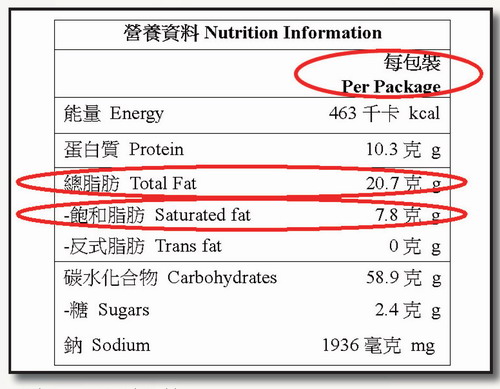
Food Safety Focus (75th Issue, October 2012) – Food Safety Platform
Want to Get Less Fat from Instant Noodles? Count on Nutrition Label
Reported by Ms. Michelle CHAN, Scientific Officer,
Risk Communication Section, Centre for Food Safety
This is the first article of a series of three that focuses on the use of nutrition labels for choosing food with lower fat, sodium and sugar content. In this article, we will introduce the three-steps to use nutrition labels (three-steps) and demonstrate how it helps reduce fat intake from instant noodles.
Take a Look at Fat
Fat is a kind of macronutrients that provides a concentrated source of energy with each gram yielding nine kilocalories (kcal). Depending on the chemical structure, fat can be divided into saturated fat and unsaturated fat. Whereas eating too much fat increases the risk of overweight and obesity, excessive saturated fat intake raises the Low Density Lipoprotein (LDL) cholesterol, commonly known as "bad" cholesterol, which in turn elevates the chance of developing heart diseases.
The World Health Organization and the Food and Agriculture Organization of the United Nations recommend that total fat and saturated fat intake should not exceed 30% and 10% of the daily energy intake respectively. Based on a 2000-kcal diet, the upper limit of the daily intake of total fat and saturated fat is about 60 g and 20 g accordingly.
Instant Noodle and Fat
Instant noodle is a popular food item in Hong Kong as well as in other places. It is mainly made with wheat flour providing a rich source of carbohydrates. During the manufacturing process, the pre-cooked and flavoured noodles undergo drying process and are compacted into its dehydrated form. The final package usually comes with a seasoning pack.
Depending on its drying process and the ingredients in the seasoning pack, the total fat and saturated fat content of instant noodles varies. While deep fried instant noodles tend to have a higher fat content, those undergo air drying or oven heating contain less fat. If palm oil, butter or lard is used in frying oil and/or seasoning oil, the saturated fat content will also increase.
Get Less Fat from Instant Noodles with Three-steps
Nutrition labelling has become part and parcel of our eating experience since the implementation of Nutrition Labelling Scheme in 2010. By following the three steps below, consumers can choose the types and amount of foods, including instant noodles, which meet their needs.
Firstly, read the nutrition label. Pay attention to the level of total fat and saturated fat. A joint Centre for Food Safety/Consumer Council study in 2010 revealed from the nutrition labels that the range of fat content among 48 instant noodle samples was wide. Those carrying the descriptions of "non-fried" or similar terms had generally lower amount of total fat and saturated fat.
Secondly, know how much I eat. Check out the reference amount on the nutrition labels for calculating nutrient intake. Usually, the nutrition labels of instant noodles are expressed as "per package". If you consume the whole pack of noodles including the seasoning, your nutrient intake will be the same as the value showed on the nutrition label. Referring to the example below, you will get 20.7 g of total fat and 7.8 g of saturated fat after consuming a whole package of instant noodle A.

Nutrition label of instant noodle A
Thirdly, make better choices. Compare your nutrient intake to your daily intake upper limit. Based on a 2000-kcal diet, consuming a pack of instant noodle A accounts for 35% and 39% of the daily limit of total fat and saturated fat respectively. To make better choices, you can:
- eat instant noodle A less frequently;
- decrease total fat and saturated fat intake from other foods on that day by adopting low fat cooking method such as steaming and grilling or avoiding food with ingredients high in saturated fat such as butter and lard; or
- use nutrition labels to choose other instant noodles with lower total fat and saturated fat content.
More Healthy Tips
Last but not least, consumers should not overlook the sodium content of instant noodles since salt in the noodle itself, the flavour enhancer and sauce in the seasoning pack all provide sodium.
In the next issue, we will show you how to get less sodium from crispy chips with the three-steps.



